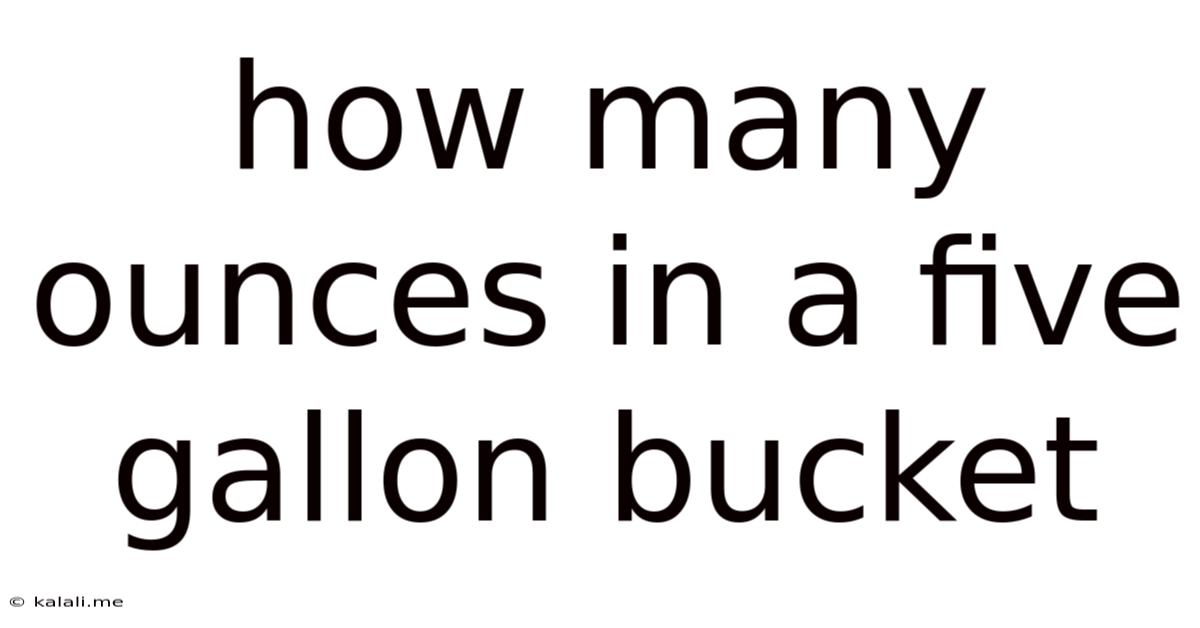How Many Ounces In A Five Gallon Bucket
Kalali
Jul 23, 2025 · 4 min read

Table of Contents
How Many Ounces in a Five-Gallon Bucket? A Comprehensive Guide
Knowing the precise volume of a five-gallon bucket, expressed in ounces, is crucial for various applications, from accurate chemical mixing in industrial settings to precise ingredient measurement in DIY projects. This comprehensive guide will not only answer the question "How many ounces are in a five-gallon bucket?" but also delve into the intricacies of liquid measurement, conversion factors, and potential variations you might encounter.
Understanding the Conversion: Gallons to Ounces
The key to solving this lies in understanding the standard unit conversions. We know that one US gallon contains 128 fluid ounces. This is a fundamental conversion factor that remains consistent across various applications. Therefore, calculating the number of ounces in a five-gallon bucket is straightforward:
5 gallons * 128 ounces/gallon = 640 ounces
Therefore, a five-gallon bucket holds 640 fluid ounces. This is assuming the bucket is completely filled to the brim.
Factors Affecting the Actual Ounce Measurement
While the theoretical calculation is simple, several factors can influence the actual amount of liquid a five-gallon bucket can hold:
-
Bucket Material: The material of the bucket can slightly affect its volume. Plastic buckets, for example, might have slightly different dimensions compared to metal buckets, leading to minor variations in capacity. This variation is usually negligible for most practical purposes but can become significant in highly precise applications.
-
Bucket Shape: A perfectly cylindrical bucket will have a consistent diameter throughout, making the volume calculation straightforward. However, some buckets might have a slightly tapered shape, resulting in a slightly smaller or larger volume than a perfect cylinder of the same stated capacity.
-
Filling Method: When filling a bucket, air bubbles can become trapped, reducing the actual liquid volume. Carefully pouring the liquid and allowing sufficient time for air bubbles to escape is essential for achieving accurate measurements, especially for critical applications.
-
Temperature: The temperature of the liquid can affect its volume due to thermal expansion. Hot liquids occupy slightly more volume than cold liquids. This effect is usually minimal for everyday purposes but should be considered in scientific experiments or industrial processes involving temperature changes.
-
Bucket Manufacturing Tolerances: Like any manufactured product, buckets are subject to manufacturing tolerances. This means that the actual dimensions and volume of a five-gallon bucket might vary slightly from the stated capacity. This variation is usually small and within acceptable industry standards but should be kept in mind for high-precision work.
Beyond the Basics: Applications and Considerations
Understanding the volume of a five-gallon bucket in ounces has numerous practical applications:
-
Chemical Mixing: In industrial settings, precise mixing of chemicals is crucial. Knowing the exact volume in ounces allows for accurate calculation of chemical ratios and concentrations.
-
DIY Projects: Many DIY projects, such as making concrete mixes, paints, or cleaning solutions, require precise measurements of ingredients. Converting gallons to ounces ensures accurate results and avoids wastage.
-
Gardening and Agriculture: Measuring fertilizers, pesticides, or other agricultural solutions often requires precise volume measurements. Converting gallons to ounces helps achieve the appropriate concentration for optimal plant growth.
-
Food Service: Restaurants and food businesses might use five-gallon buckets for storing large quantities of ingredients. Knowing the volume in ounces helps with inventory management and portion control.
-
Emergency Preparedness: Storing water in five-gallon buckets for emergency situations requires understanding the total volume to ensure adequate supplies.
-
Scientific Experiments: In laboratories, precise volume measurements are critical for experiments involving liquids. Converting gallons to ounces allows for accurate recording and reproduction of experiments.
Working with Different Liquid Measurements
While ounces are a common unit for liquid measurement, especially in the US, other units are used internationally and in specific industries:
-
Liters (L): The metric system uses liters as the primary unit for liquid volume. One US gallon is approximately equal to 3.785 liters.
-
Milliliters (mL): A milliliter is one-thousandth of a liter. It's frequently used for smaller liquid volumes.
-
Cubic centimeters (cc or cm³): One milliliter is equal to one cubic centimeter, making these units interchangeable for liquid volume.
-
Pints, Quarts: These are other common units used in the US customary system, often used in conjunction with gallons.
Converting Gallons to Other Units:
To further illustrate the versatility of these conversions, let's consider how to convert five gallons to other common units:
- Liters: 5 gallons * 3.785 liters/gallon ≈ 18.925 liters
- Milliliters: 18.925 liters * 1000 mL/liter = 18925 mL
- Cubic centimeters: 18925 cc (since 1 mL = 1 cc)
Conclusion:
The conversion of a five-gallon bucket's volume into ounces is a fundamental calculation in many fields. While the basic conversion of 640 ounces is straightforward, understanding the potential variations due to bucket material, shape, and filling methods is essential for accuracy in practical applications. By considering these factors and mastering the related conversions to liters and milliliters, you can confidently handle liquid volume measurements in various situations, ensuring accurate results in any project or experiment. Remember to always prioritize precision when working with liquids, particularly in sensitive contexts.
Latest Posts
Latest Posts
-
Do Colleges Have Classes On Columbus Day
Jul 23, 2025
-
How Many Square Feet Is 27 Acres
Jul 23, 2025
-
What Was Mary And Josephs Last Name
Jul 23, 2025
-
How Much Is 38 Kilos In Pounds
Jul 23, 2025
-
How Many Cups In 4 Ounces Of Chocolate Chips
Jul 23, 2025
Related Post
Thank you for visiting our website which covers about How Many Ounces In A Five Gallon Bucket . We hope the information provided has been useful to you. Feel free to contact us if you have any questions or need further assistance. See you next time and don't miss to bookmark.